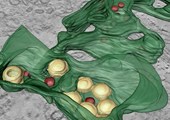
28.08.2013 -
The cover of the August 2013 issue of the Journal of
Virology shows a high-resolution 3D image of the cytoplasmic
compartments of tick-borne encephalitis virus (TBEV) obtained by
electron tomography through a collaborative effort between the
group of Molecular Virology lead by Alessandro
Marcello at the ICGEB in Trieste and Ralf
Bartenschlager in Heidelberg. The full
article in the same journal describes how the virus modifies
intracellular membranes to create a protective environment for its
own replication. 'Seeing is believing' says A. Marcello 'only by
providing high definition imaging of viral infections we can fully
understand the life cycle of pathogenic viruses'.
Lisa Miorin, the ICGEB doctoral student who performed the
work started by developing a novel technique pioneered
in Trieste to track viral genomes in living cells. She observed
that following infection the viral replicated RNA was progressively
immobilized within perinuclear compartments that protected viral
replication from the host cellular innate antiviral
response. However, in order to analyze these structures in
more detail, she moved to Heidelberg, thanks to a short-term EMBO
Fellowship, where she could get access to advanced electron
tomography techniques. There she could show that these compartments
were composed of small vesicles, where the viral RNA is replicated,
and larger compartments, where the replicated RNA is triaged for
further rounds of translation/replication or assembly. After
completing this work and discussing her doctoral thesis at the
University of Nova Gorica in Slovenia, Lisa moved to
New York as a postdoc in the group of Adolfo Garcia Sastre at the
Mount Sinai School of Medicine where she still remained interested
in the host response to viral infections.
Such success stories of its doctoral students highlight
the ICGEB PhD Program restless effort to select highly
motivated candidates and to provide them with a dynamic and
international environment where they can grow to become fully
independent scientists.